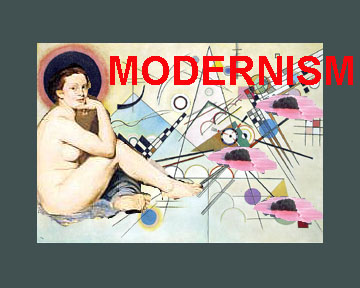 |
Modernism was revolutionary during the 20th century. Women
wanted to win equal rights in the patriarchal world of government, politics,
society, employment, and most importantly, art. "In Western art, movements
and "isms" appeared, one after another: impressionism,
postimpressionism, fauvism, cubism, futurism, constructivism, dada-ism,
surrealism, expressionism, abstract expressionism, etc." (Guerilla Girls,
59). All these extraordinary movements and new forms of expression
revolutionized art and became known as modernism.
Women in Europe were finding different ways of expression
through many different types of art. Although men were still superior, women
were firmly making their way through art. Through fashion, art and expression
was able to take form. Margaretha von Brauchitsch, a craftswoman, focused her
art on embroidery design in Munich that received notice in Paris, France
(Chadwick, 253). The Omega Workshops in London was a place where women came
together to express their ideas through design. Vanessa Bell designed dressed in
the Omega Workshops that were "too exotic for the Omega's clientele"
(Chadwick, 260). The colors and the way the clothes were organized and put
together were very unordinary.
While these women were expressing art through fashionable
apparel, Sonia Delaunay “designed book covers, posters, lampshades, curtains,
cushion covers, and other objects for her home” (Chadwick, 261). Although she was very talented in her work,
her husband, Robert Delaunay, took her shine. However, together they developed
simultanism, a theory of color (Guerilla Girls, 60). Sonia was very innovative while
her husband basically stood to what he knew. She was always improving, and if
it weren’t for her, her husband would not be as successful as he was.
When looking at their art side by side, you can see the
differences and the depths both artists use to express themselves. The
precision and brushstrokes are different. The stories both artists are telling
are different. Also, the shapes used are totally different. However, side by
side, you cannot tell the difference between which one was done by a female or
a male.
 |
| Sonia Delaunay |
 |
| Robert Delaunay |
Dada was influenced by World War I and avant-garde
movements. The art was not necessarily beautiful, but it was an expression of
how society felt and the position the artists had. In a catalogue for an
exhibition Jean Arp, an artists, wrote “These works are put together from
lines, planes, forms, and colors. They are a reaction between human egotistical
concerns” (Chadwick, 272). Jean Arp’s Paper
Cut with Paper Cutter was not the ordinary art that was known to society. Her
art expressed her not striving for perfection.
 |
| Example of Jean Arp's Art |
Shapes and different materials were not the only things
being modernized through art. The way a woman dressed in society was evolving.
Nancy Cunard, had “adapted sportswear to daily life and capitalized on
feminizing masculine fashion, posing in the “little black dress” that became
the hallmark of 1930s fashion and was photographed by Man Ray” (Chadwick, 276).
She wanted the “new woman” to be modern. Women also began to work industrial
jobs and began receiving recognition for being independent and responsible
after World War I.
 |
| Fashion and Art |
The body of a women was also being recognized and modernized
through art. “The difficulty of distinguishing between overtly sexualized and
other forms of looking, the issue of female subjectivity and the identification
of the female body with nature, generation, and the instinctual life have
become important areas of investigation for contemporary feminism” (Chadwick,
282). A woman’s body was used throughout history for the male gaze and for the
pleasure of men. Their bodies were sexualized and objectified in art. With
modernism, women artists were able to take a woman’s body and draw or paint it
in a normal state, with no sexualized expressions. Suzanne Valadon was able to
present the female in their normal states “emphasizing the awkward gestures of
figures apparently in control of their own movements” (Chadwick, 285). She
painted women in their natural state and this art expressed the natural woman.
Frida Kahlo also expressed herself through self-portraits. The pain that she
endured in her life are all depicted through her paintings. It depicts women do
have feelings and are powerful to overcome or deal with such feelings. It
shows, once again, the normal life of a woman rather than an objectified and
sexualized one.
Modernism was a combination of all “isms” throughout the
history of art. Women revolutionized the way they were depicted, the way they
dressed, the status they held in society, the difference in nudes and many
more. The way women expressed different new forms of art revolutionized the way
many women express themselves and dress today. Many men would not have received
any inspiration or have adopted new techniques if it were not for women who
pushed these innovations forward.
Attached below is a video on the timeline of modernism which makes it easier for one to under what is modernism and how has it affected art history and a video of Sonia Delaunay.
Attached below is a video on the timeline of modernism which makes it easier for one to under what is modernism and how has it affected art history and a video of Sonia Delaunay.
Modernism in Art
Sonia Delaunay
https://www.youtube.com/watch?v=61dz-2dL3Hc
Works Cited
Chadwick, W. (2012). Women, Art, and Society (5th ed.). New York, NY: Thames and Hudson.
Guerrilla Girls (1998). The Guerrilla Girls' Bedside Companion to the History of Western Art. New York, NY: Penguin Books.
No comments:
Post a Comment